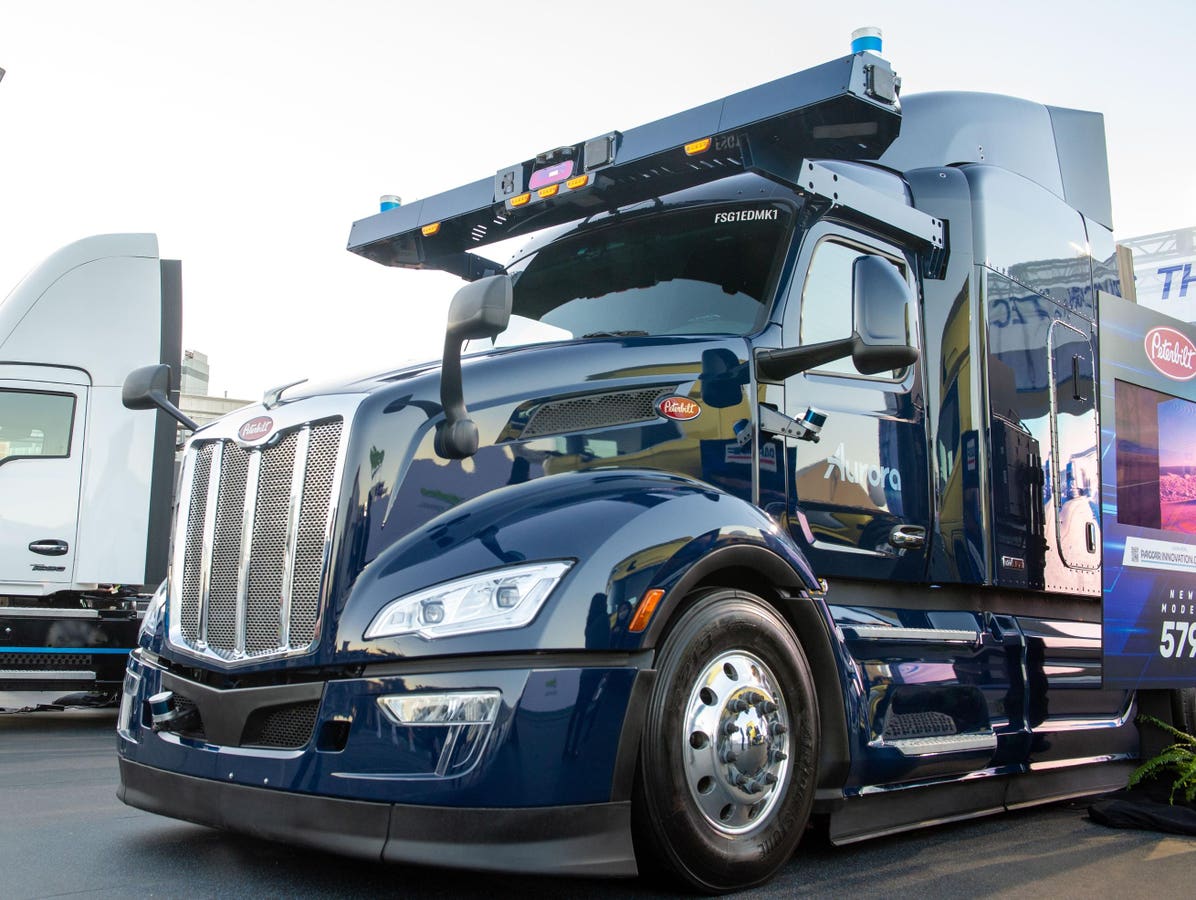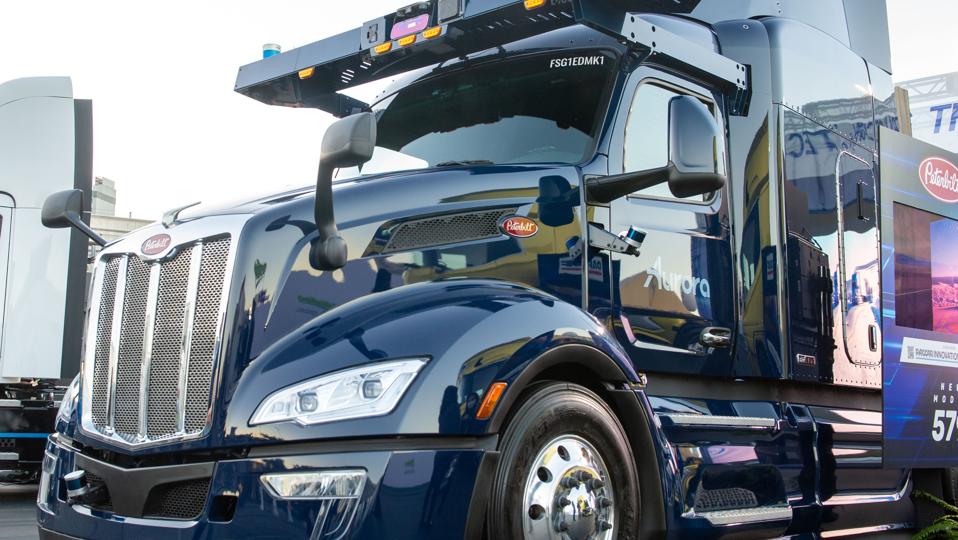Robotic truck company Aurora shows off a self-driving semi-truck at the CES tech show in Las Vegas.
A quiet revolution is reshaping America’s trucking industry, and it’s about to transform how trucking accident cases are fought in courtrooms across the country. Semi-autonomous systems—where drivers monitor AI-controlled vehicles—are already being deployed across commercial fleets, while companies like Aurora have logged five million fully autonomous commercial miles, proving that driverless freight is no longer science fiction.
For the legal industry, this technological shift represents one of the most significant changes in commercial transportation litigation since the interstate highway system was built. With both human drivers and AI systems “behind the wheel,” the fundamental nature of legal liability is being rewritten.
To understand why this matters, consider how trucking accident cases are typically fought today. I interviewed Kenneth Williams, Transportation Practice Leader at the law firm Segal McCambridge, who has spent decades defending trucking companies in court. For the past fifteen years, plaintiff attorneys have relied heavily on “Reptile Theory,” a litigation strategy designed to activate jurors’ primitive survival instincts and make them feel that corporate conduct threatens community safety.
This emotional approach has proven remarkably effective, generating billions in verdicts and settlements. As Williams explains, common questions include, “Does the trucking company agree that safety must be paramount?” and “A company must make the safest possible choice in all circumstances, correct?” These questions attempt to force defendants to agree with broad safety principles, then use those agreements to argue any deviation endangered the community.
While data from today’s trucks is already used by experts for accident reconstruction and determining driver distraction, the widespread adoption of semi-autonomous trucking systems will create more data, giving the truck more of a “voice” in litigation. These systems require drivers to monitor AI-controlled vehicles, but the AI handles part of the driving decisions. As Williams explains, “In near future jury trials involving commercial trucking litigation, you will hear from the commercial owner and from the driver, but the jury is now going to hear a new voice. They’re going to hear from the vehicle itself—and vehicles don’t give conflicting testimony, don’t forget, and don’t get nervous on the witness stand.”
Litigation Strategy Will Change
As this technology continues to advance, litigation strategy will fundamentally shift from subjective human testimony to objective machine data. Instead of relying on a driver’s recollection of events that occurred in milliseconds during a high-stress situation, through experts, legal teams can access precise sensor data showing exactly what the vehicle detected, when it detected it, and how the AI system responded. This includes everything from the exact speed and trajectory of surrounding vehicles to weather conditions, road surface quality, and even the driver’s attention level as monitored by interior cameras and biometric sensors.
The data richness extends beyond the moment of impact. Modern semi-autonomous systems continuously monitor and log driver behavior, creating detailed profiles of attention patterns, response times, and compliance with system alerts. This information provides unprecedented insight into the human-machine interaction that defines semi-autonomous operation, offering litigators objective evidence of driver performance that was previously impossible to obtain.
As increasingly autonomous systems become more prevalent in commercial trucks, the litigation advantage will shift dramatically toward those who can secure and effectively utilize technical experts, but this shift also fundamentally changes litigation economics. Williams outlined the comprehensive expert team that will become essential, and why insurance carriers need to start wrestling with questions like, “Are you pricing policies to incorporate a digital forensic expert, an artificial intelligence expert, a biomechanical engineer, an accident reconstructionist, and a human factors expert on every case involving autonomous trucks? Let alone your medical doctors and toxicologists. Companies like Rimkus that are at the forefront of data retrieval, data interpretation, and AI expertise—that’s who will be the industry leaders in assisting litigators.”
The Human Element Remains
Williams noted the demographic implications: “The ramifications will impact who’s on your jury. All the kids familiar with TikTok, WhatsApp, Instagram—they’re miles ahead in technology compared to war veterans, retired school teachers, and end-of-career white-collar professionals.”
However, even tech-savvy jurors need expert guidance to understand complex AI decision-making processes. The challenge lies in making sophisticated technology accessible to jurors with varying technical backgrounds while maintaining emotional resonance.
As Williams explains, the most successful litigation teams will combine technical accuracy with compelling human narratives. They’ll explain not just what the AI system did, but why those decisions matter for human safety and justice.
The Shift from Personal Injury to Product Liability
Perhaps the most fundamental legal transformation will be the gradual shift from traditional personal injury claims to product liability cases. In conventional trucking accidents, liability typically centers on driver negligence—whether the driver was distracted, fatigued, speeding, or otherwise failed to exercise reasonable care. The legal framework focuses on human error and company policies around driver training, hours of service, and vehicle maintenance.
As AI systems assume greater control over vehicle operations, the liability calculus fundamentally changes. When an autonomous system makes a split-second decision that results in an accident, the question shifts from “did the driver act reasonably?” to “did the AI system function as designed?” This transformation moves cases from the realm of personal injury law—where human behavior is scrutinized—into product liability territory, where the focus becomes whether the technology itself was defective.
Williams expects this shift to reshape commercial vehicle accident litigation, creating distinct categories of legal arguments. “Instead of arguing whether a driver should have seen a hazard or reacted faster, we’ll be arguing whether the AI’s object recognition algorithms were adequate, whether the sensors worked properly, or whether the decision-making protocols were reasonable given the circumstances,” he explains.
This evolution has profound implications for how cases are prepared and tried. Product liability cases require different expertise, different discovery processes and different legal theories. Rather than deposing drivers about their training and experience, attorneys will need to engage experts in software engineering, data science and artificial intelligence. The focus shifts from company safety policies to algorithmic decision-making processes and driver logs to code repositories.
The transition also affects damages calculations. In traditional personal injury cases, damages often reflect the individual driver’s actions and the trucking company’s vicarious liability. In product liability cases, damages may encompass broader questions about whether entire fleets of vehicles share the same algorithmic vulnerabilities, potentially exposing manufacturers to massive aggregate liability that dwarfs today’s trucking settlements.
For insurance carriers, this shift represents a fundamental recalibration of risk assessment. The predictable patterns of human error that have long guided actuarial models give way to the more complex challenge of quantifying AI system reliability across millions of driving scenarios.
The Coming Competitive Advantage
While the full transformation remains years away, competitive advantages in the courtroom are already emerging. Williams emphasized: “Success will depend entirely on securing the best data interpretation experts early in the process. In this new reality, the side with superior technical expertise doesn’t just have an advantage—they have an insurmountable one.”
The window for preparation is open now. As Aurora expands operations and other manufacturers accelerate deployment with semi-autonomous and fully autonomous commercial vehicles, those who build expert networks and develop technical competencies early will dominate the industry.
The autonomous trucking revolution will transform commercial transportation litigation from emotion-driven to expert-driven. While human emotions and compelling narratives will remain important, the attorneys and insurance companies who can best interpret and present complex technical data in understandable, emotionally resonant ways will control the courtroom.
The change is coming. The full transformation may take years, but the time to build expert relationships and develop technical competencies is now.




